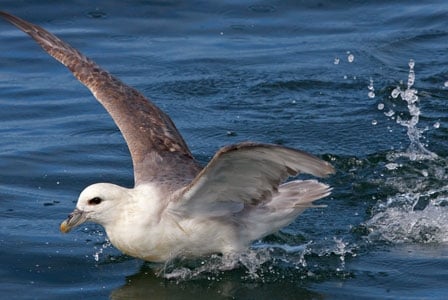
A new study shows that plastic pollution off the Pacific Northwest coast has dramatically increased over the last 40 years.
It’s a depressing thought: seabirds gobbling up all our discarded detritus. But, the fact is that during the last four decades there has been “a substantial increase in plastic pollution” in the waters off the Pacific Northwest coast, according to a new study just published in the journal, Marine Pollution Bulletin.
Northern fulmars are the canaries in the ocean
Researchers have settled on a way to monitor this pollution: they study the stomach contents of beached seabirds called northern fulmars. They chose this bird because of its particular eating habits—fulmars don’t regurgitate the plastic they consume from the surface of the ocean—as well as the fact that it seldom ventures to shore.
There are plenty of other marine species—more than 260—including turtles, fish, and seabirds, that are known to either become entangled in plastic or ingest it. Scientists estimate that around the world, up to one million seabirds and 100,000 marine mammals and sea turtles die each year from eating plastic.
But northern fulmars are the species of choice when it comes to monitoring and comparing plastic pollution between different regions of the world because of their migratory range and propensity to eat anything that floats.
“Like the canary in the coal mine, northern fulmars are sentinels of plastic pollution in our oceans,” said Stephanie Avery-Gomm, the study’s lead author and a graduate student in University of British Columbia’s Department of Zoology. “Their stomach content provides a ‘snapshot’ sample of plastic pollution from a large area of the northern Pacific Ocean.”
More plastic is feeding more seabirds
Studies of fulmars done in the 1970s and 1980s showed that 84 percent had plastic in their stomach as opposed to Avery-Gomm’s study which found 92.5 percent. As well, the average amount of plastic in each bird increased from .04 grams in the earlier studies to .385 grams. “Plastic ingestion in these fulmars is among the highest recorded globally,” according to the published study.
More needs to be done
Avery-Gomm believes more needs to be done to establish regular monitoring of the plastic ingested by northern pulmars, since no official group is currently doing this. In the meantime, she suggests ocean and beach cleaning programs could help reduce the amount of pollution.
“If people are aware of the problem they can also reconsider their use of plastic, especially single-use plastic. I certainly have,” she said. “Since starting this project I see plastic everywhere.”

